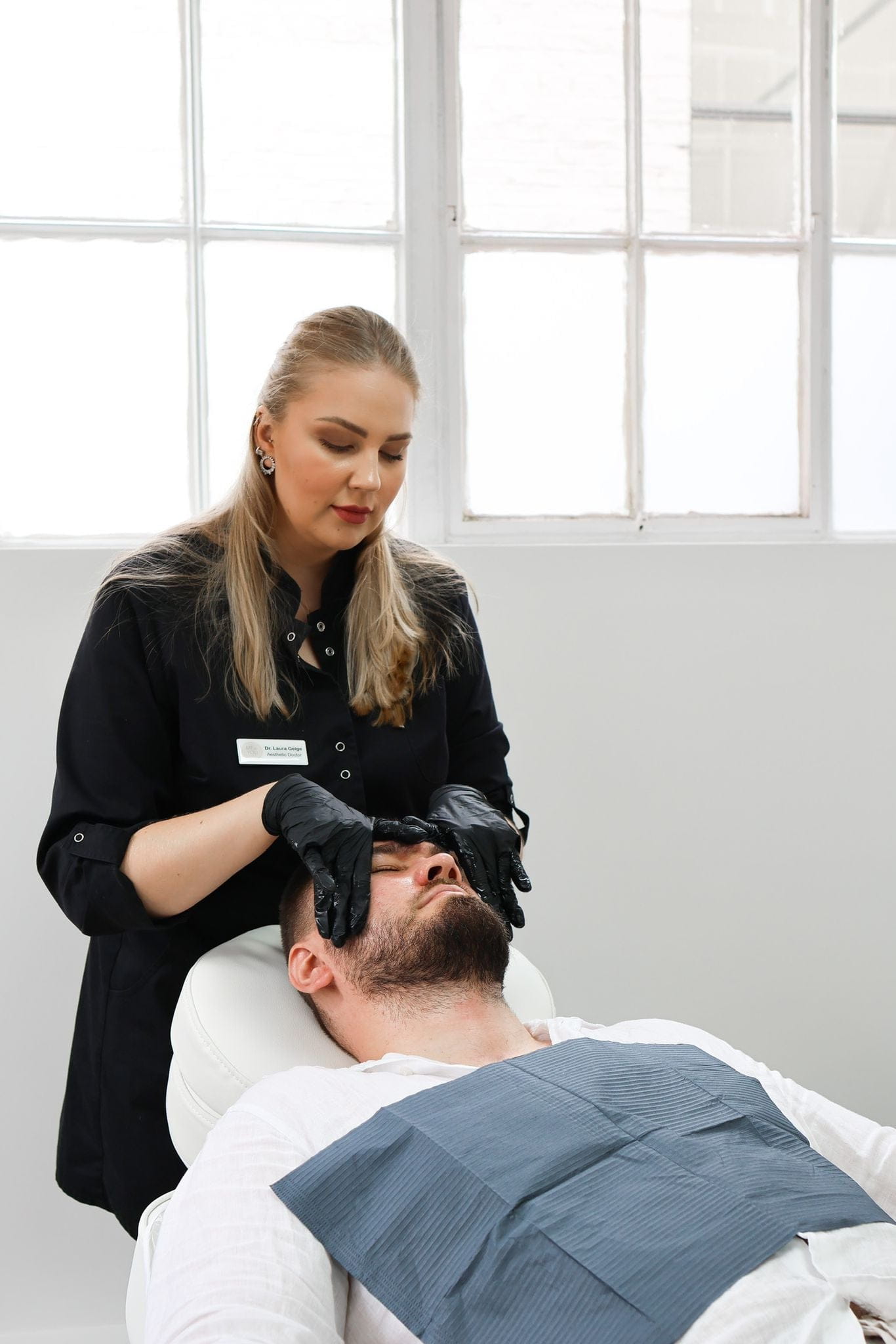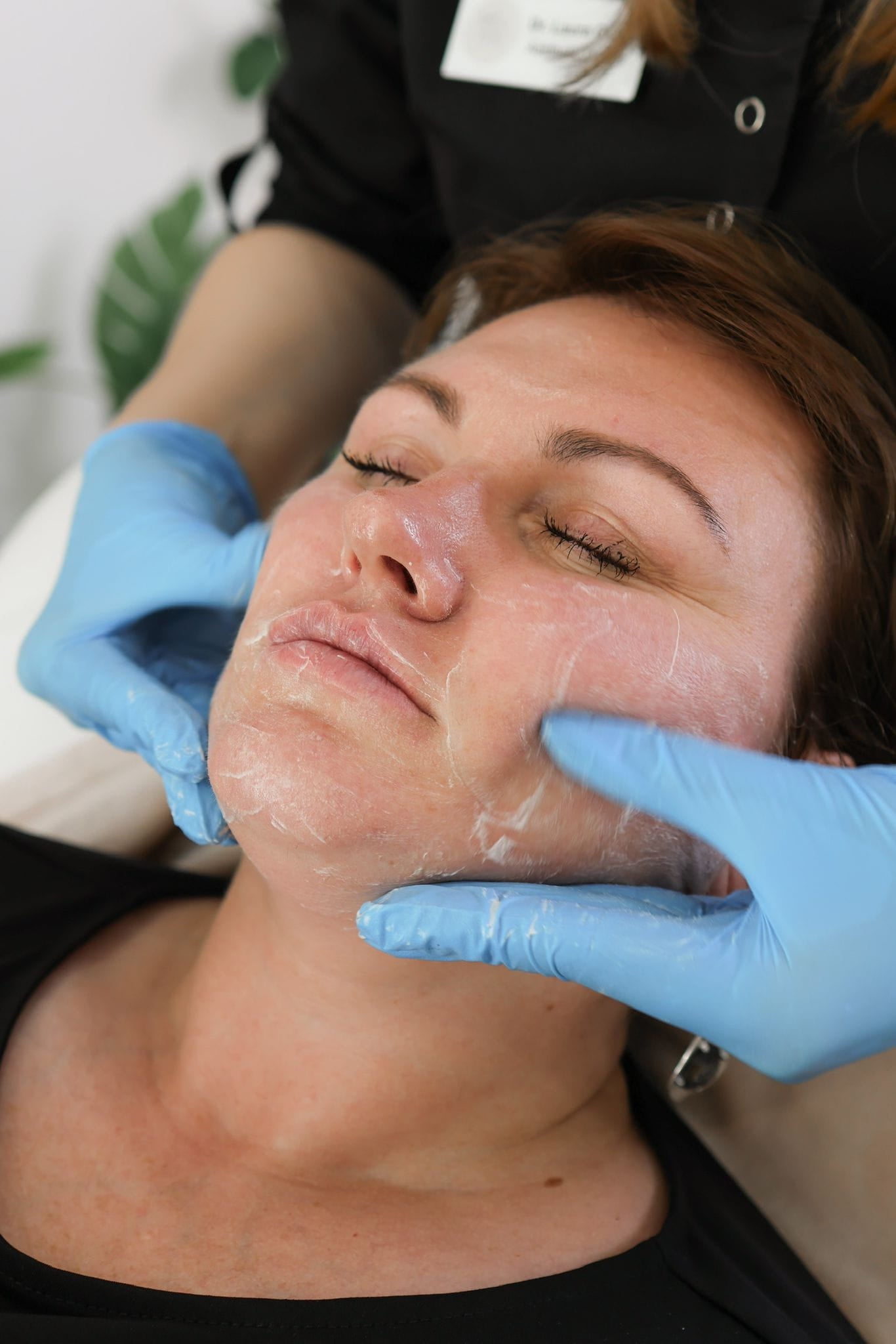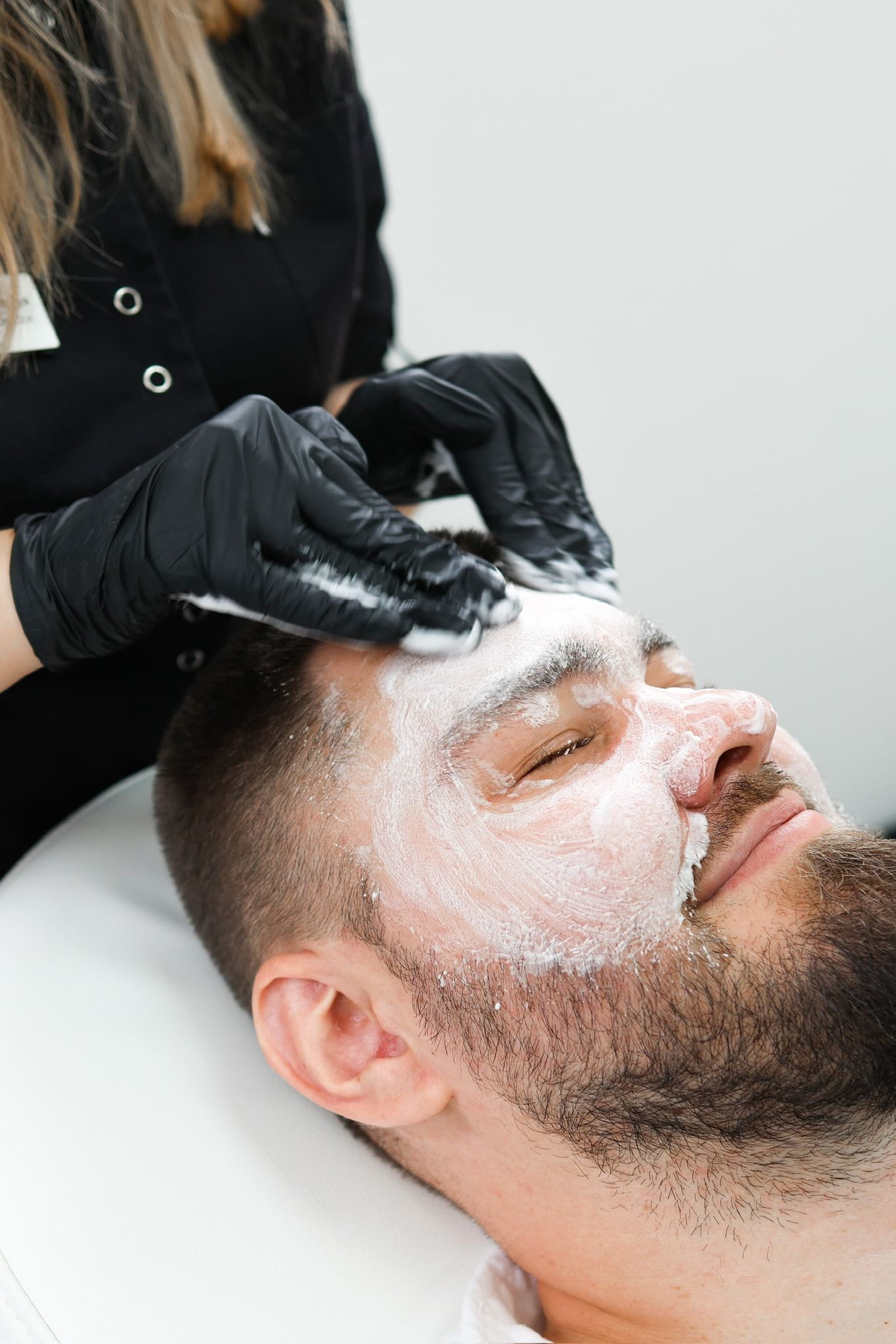Cosmelan Depigmentation Peel
For individuals seeking to address pigmentation issues like age spots, sun damage, and melasma, two popular treatments stand out: the Cosmelan Depigmentation Peel and laser therapy. Both offer promising results in reducing pigmentation, but they operate through distinct mechanisms and possess unique advantages and considerations.
Mechanism of Action
Cosmelan Depigmentation Peel is a chemical peel that utilizes a combination of potent depigmenting agents. These agents work by inhibiting the production of melanin, the pigment responsible for skin color. The primary active ingredients in Cosmelan are kojic acid, azelaic acid, and hydroquinone. Kojic acid interferes with tyrosinase, the enzyme responsible for melanin synthesis, while azelaic acid has both anti-inflammatory and depigmenting properties. Hydroquinone acts as a powerful tyrosinase inhibitor, blocking melanin production.
Benefits
The Cosmelan Depigmentation Peel offers several benefits compared to laser therapy. Firstly, it is typically less invasive than laser treatments, often requiring just one application for significant results. This reduces downtime and discomfort for patients. Additionally, Cosmelan can be a more cost-effective option compared to multiple sessions of laser treatment.
Furthermore, Cosmelan can address a wider range of pigmentation concerns, including melasma, sunspots, and post-inflammatory hyperpigmentation. It effectively targets both the surface and deeper layers of the skin, leading to long-lasting results.
Suitable Skin Types
Cosmelan is generally suitable for individuals with Fitzpatrick skin types I to V.
However, it’s important to note that darker skin tones may require a more gradual approach and careful monitoring by a qualified dermatologist or esthetician to minimize the risk of post-inflammatory hyperpigmentation.
Downtime and Recovery
Both Cosmelan Depigmentation Peel and laser therapy are effective treatments for pigmentation issues, but they differ in their mechanisms and downtime requirements.
- Cosmelan Depigmentation Peel is a chemical peel that involves the application of a potent depigmenting solution to the skin. The peel works by inhibiting melanin production, reducing the appearance of age spots, sun damage, and melasma.
- Laser therapy uses focused beams of light to target and destroy pigment-producing cells in the skin, resulting in lighter pigmentation over time.
Laser treatments often require multiple sessions and can involve more downtime, as the skin needs time to heal. Cosmelan, on the other hand, typically only requires one application and has a shorter recovery period.
Cosmelan is generally suitable for Fitzpatrick skin types I to V, although darker skin tones may require a more gradual approach under the supervision of a dermatologist or esthetician.
Cost in the UK
The cost of Cosmelan Depigmentation Peel in the UK can vary depending on the practitioner’s experience, location, and the size of the area being treated. Generally, expect to pay between £300 and £600 for a single treatment session.
It’s important to note that this is just an estimated price range, and it’s always best to consult with a qualified practitioner to get an accurate quote based on your individual needs.
Laser Treatment for Hyperpigmentation
For individuals seeking to address pigmentation issues like age spots, sun damage, and melasma, two popular treatments stand out: the Cosmelan Depigmentation Peel and laser therapy. Both offer promising results in reducing pigmentation, but they operate through distinct mechanisms and possess unique advantages and considerations.
Types of Lasers Used
Laser treatment for hyperpigmentation utilizes focused beams of light energy to target and break down melanin, the pigment responsible for skin color. Different types of lasers are used depending on the specific type of pigmentation being treated and individual skin characteristics.
Some commonly used lasers include:
- Q-switched Nd:YAG lasers: Effective for treating darker pigmented lesions like age spots, tattoos, and melasma.
- Fractional CO2 lasers: Can resurface the skin and reduce pigmentation by stimulating collagen production.
- IPL (Intense Pulsed Light) therapy: A broad-spectrum light source that targets multiple pigments, suitable for sun damage and freckles.
How It Works
Laser treatment for hyperpigmentation utilizes focused beams of light energy to target and break down melanin, the pigment responsible for skin color. Different types of lasers are used depending on the specific type of pigmentation being treated and individual skin characteristics.
Some commonly used lasers include:
- Q-switched Nd:YAG lasers: Effective for treating darker pigmented lesions like age spots, tattoos, and melasma.
- Fractional CO2 lasers: Can resurface the skin and reduce pigmentation by stimulating collagen production.
- IPL (Intense Pulsed Light) therapy: A broad-spectrum light source that targets multiple pigments, suitable for sun damage and freckles.
Benefits
Laser treatment offers several advantages for addressing hyperpigmentation. Firstly, it can effectively target a wide range of pigmentation concerns, including age spots, sun damage, melasma, and post-inflammatory hyperpigmentation.
Lasers can penetrate deeper into the skin than topical treatments, reaching the melanin-producing cells responsible for pigmentation. This allows for more significant and lasting results. Additionally, laser treatments often lead to a smoother skin texture by stimulating collagen production.
It is important to note that laser treatment may require multiple sessions spaced weeks apart to achieve optimal results.
Downtime after laser treatment can vary depending on the type of laser used and individual skin sensitivity. Some individuals may experience redness, swelling, or crusting for a few days to a week.
Suitable Skin Types
Cosmelan Depigmentation Peel is a chemical peel that utilizes a combination of potent depigmenting agents. These agents work by inhibiting the production of melanin, the pigment responsible for skin color. The primary active ingredients in Cosmelan are kojic acid, azelaic acid, and hydroquinone. Kojic acid interferes with tyrosinase, the enzyme responsible for melanin synthesis, while azelaic acid has both anti-inflammatory and depigmenting properties. Hydroquinone acts as a powerful tyrosinase inhibitor, blocking melanin production.
Cosmelan Depigmentation Peel offers several benefits compared to laser therapy. Firstly, it is typically less invasive than laser treatments, often requiring just one application for significant results. This reduces downtime and discomfort for patients. Additionally, Cosmelan can be a more cost-effective option compared to multiple sessions of laser treatment.
Furthermore, Cosmelan can address a wider range of pigmentation concerns, including melasma, sunspots, and post-inflammatory hyperpigmentation. It effectively targets both the surface and deeper layers of the skin, leading to long-lasting results.
Cosmelan is generally suitable for individuals with Fitzpatrick skin types I to V.
However, it’s important to note that darker skin tones may require a more gradual approach and careful monitoring by a qualified dermatologist or esthetician to minimize the risk of post-inflammatory hyperpigmentation.
Both Cosmelan Depigmentation Peel and laser therapy are effective treatments for pigmentation issues, but they differ in their mechanisms and downtime requirements.

- Cosmelan Depigmentation Peel is a chemical peel that involves the application of a potent depigmenting solution to the skin. The peel works by inhibiting melanin production, reducing the appearance of age spots, sun damage, and melasma.
- Laser therapy uses focused beams of light to target and destroy pigment-producing cells in the skin, resulting in lighter pigmentation over time.
Laser treatments often require multiple sessions and can involve more downtime, as the skin needs time to heal. Cosmelan, on the other hand, typically only requires one application and has a shorter recovery period.
Cosmelan is generally suitable for Fitzpatrick skin types I to V, although darker skin tones may require a more gradual approach under the supervision of a dermatologist or esthetician.
Downtime and Recovery
Laser treatment for hyperpigmentation utilizes focused beams of light energy to target and break down melanin, the pigment responsible for skin color. Different types of lasers are used depending on the specific type of pigmentation being treated and individual skin characteristics.
Some commonly used lasers include:
- Q-switched Nd:YAG lasers: Effective for treating darker pigmented lesions like age spots, tattoos, and melasma.
- Fractional CO2 lasers: Can resurface the skin and reduce pigmentation by stimulating collagen production.
- IPL (Intense Pulsed Light) therapy: A broad-spectrum light source that targets multiple pigments, suitable for sun damage and freckles.
Laser treatment offers several advantages for addressing hyperpigmentation. Firstly, it can effectively target a wide range of pigmentation concerns, including age spots, sun damage, melasma, and post-inflammatory hyperpigmentation.
Lasers can penetrate deeper into the skin than topical treatments, reaching the melanin-producing cells responsible for pigmentation. This allows for more significant and lasting results. Additionally, laser treatments often lead to a smoother skin texture by stimulating collagen production.
It is important to note that laser treatment may require multiple sessions spaced weeks apart to achieve optimal results.
Downtime after laser treatment can vary depending on the type of laser used and individual skin sensitivity. Some individuals may experience redness, swelling, or crusting for a few days to a week.
Cost in the UK
The cost of laser treatment for hyperpigmentation in the UK can vary significantly depending on factors such as the practitioner’s experience, location, the type of laser used, and the size of the area being treated. Generally, you can expect to pay between £200 and £500 per session.
Multiple sessions are often required to achieve desired results, so the total cost can be higher depending on your individual needs.
Comparison of Cosmelan and Laser Treatment
For individuals seeking solutions to pigmentation issues like age spots, sun damage, and melasma, two popular treatment options stand out: Cosmelan Depigmentation Peel and laser therapy. Both treatments offer promising outcomes in reducing pigmentation, but they differ significantly in their mechanisms and have unique advantages and considerations.
Efficacy
Both Cosmelan Depigmentation Peel and laser therapy are effective treatments for addressing pigmentation concerns.
Cosmelan is a chemical peel that works by inhibiting melanin production through potent ingredients like kojic acid, azelaic acid, and hydroquinone. It offers several advantages over laser treatment, including less invasiveness, typically requiring only one application for significant results, and being more cost-effective due to fewer sessions needed. Cosmelan also addresses a wider range of pigmentation issues, effectively targeting both surface and deeper skin layers.
Laser therapy utilizes focused light beams to target and destroy pigment-producing cells. Different types of lasers are used depending on the specific pigmentation concern, such as Q-switched Nd:YAG lasers for darker lesions and Fractional CO2 lasers for resurfacing and collagen stimulation. Laser treatment often requires multiple sessions spaced weeks apart and may involve more downtime for healing compared to Cosmelan.
While both treatments are effective, the best choice depends on individual needs and skin type.
Side Effects and Risks
For individuals seeking solutions to pigmentation issues like age spots, sun damage, and melasma, two popular treatment options stand out: Cosmelan Depigmentation Peel and laser therapy. Both treatments offer promising outcomes in reducing pigmentation, but they differ significantly in their mechanisms and have unique advantages and considerations.
Cosmelan Depigmentation Peel is a chemical peel that works by inhibiting melanin production through potent ingredients like kojic acid, azelaic acid, and hydroquinone. It offers several advantages over laser treatment, including less invasiveness, typically requiring only one application for significant results, and being more cost-effective due to fewer sessions needed. Cosmelan also addresses a wider range of pigmentation issues, effectively targeting both surface and deeper skin layers.
Laser therapy utilizes focused light beams to target and destroy pigment-producing cells. Different types of lasers are used depending on the specific pigmentation concern, such as Q-switched Nd:YAG lasers for darker lesions and Fractional CO2 lasers for resurfacing and collagen stimulation. Laser treatment often requires multiple sessions spaced weeks apart and may involve more downtime for healing compared to Cosmelan.
Both treatments are effective, but the best choice depends on individual needs and skin type.
Factors to consider when choosing between Cosmelan and laser therapy include:
- Severity of pigmentation:
- Skin type:
- Desired results:
- Budget:
- Downtime tolerance:
It’s important to consult with a qualified dermatologist or esthetician to determine the most suitable treatment option and discuss potential risks and side effects.
Duration of Results
Cosmelan Depigmentation Peel and laser therapy are both effective treatments for pigmentation issues, but they work in different ways and have distinct advantages.
Cosmelan is a chemical peel that uses a potent solution containing kojic acid, azelaic acid, and hydroquinone to inhibit melanin production. It’s typically less invasive than laser treatment, requiring only one application for significant results. Cosmelan is often more cost-effective as it requires fewer sessions. It also addresses a wider range of pigmentation concerns, including melasma, sun spots, and post-inflammatory hyperpigmentation.
Laser therapy uses focused light beams to target and destroy pigment-producing cells in the skin. Different types of lasers are used depending on the specific pigmentation concern, such as Q-switched Nd:YAG lasers for darker lesions and fractional CO2 lasers for resurfacing and collagen stimulation. Laser treatment often requires multiple sessions spaced weeks apart and may involve more downtime for healing than Cosmelan.

**Duration of Results:**

* **Cosmelan:** Results from a Cosmelan peel can last for several months to years, depending on sun exposure and skincare habits. Maintenance treatments may be needed over time to maintain results.
* **Laser Therapy:** Laser treatment results are generally longer-lasting than Cosmelan, with some patients seeing lasting improvement after a few sessions. However, like Cosmelan, maintenance treatments might be recommended to address any new pigmentation that develops.
The best choice between Cosmelan and laser therapy depends on individual factors such as the severity of pigmentation, skin type, desired results, budget, and downtime tolerance. It’s crucial to consult with a qualified dermatologist or esthetician for personalized advice and to discuss potential risks and side effects.
Maintenance Requirements
Cosmelan Depigmentation Peel and laser therapy are both effective treatments for addressing hyperpigmentation concerns like age spots, sun damage, and melasma. However, they work through different mechanisms and have distinct advantages.
**Cosmelan Depigmentation Peel:**
* **Mechanism:** This chemical peel uses a potent solution containing kojic acid, azelaic acid, and hydroquinone to inhibit melanin production at the source.
* **Advantages:**
* Less invasive than laser therapy, typically requiring only one application for significant results.
* More cost-effective as fewer sessions are needed.
* Addresses a wider range of pigmentation concerns.
* **Maintenance:** Results can last for several months to years with proper sun protection and skincare habits. Maintenance treatments may be recommended periodically to maintain optimal results.
**Laser Therapy:**
* **Mechanism:** Utilizes focused light beams (different types depending on the target pigment) to directly destroy melanin-producing cells in the skin.
* **Advantages:**
* Can achieve long-lasting results with multiple sessions.
* Can also stimulate collagen production, improving skin texture and reducing fine lines.
* **Maintenance:** Similar to Cosmelan, regular sun protection and skincare are crucial to maintain results. Repeat treatments may be needed over time.
**Choosing the Best Option:**
The ideal treatment depends on individual factors:
* **Severity of pigmentation:** Laser therapy might be more suitable for deeper or darker pigmentation concerns.
* **Skin type:** Certain skin types are more sensitive to laser treatments, requiring careful consideration and potentially a gradual approach.
* **Desired results:** For long-lasting results, laser therapy may be preferred, but Cosmelan offers faster initial improvements.
* **Budget:** Cosmelan is generally more cost-effective due to fewer sessions needed.
* **Downtime tolerance:** Laser treatments often involve more downtime for healing compared to Cosmelan.
Consulting with a qualified dermatologist or esthetician is crucial for determining the most appropriate treatment and discussing potential risks and side effects.
- Hierarchical Vs Non-Hierarchical Polyamory: Key Differences - May 6, 2025
- Exosome Therapy For Skin Rejuvenation Near Cranleigh, Surrey - May 5, 2025
- Neck Line Filler Treatment Near Bourne, Surrey - May 5, 2025

